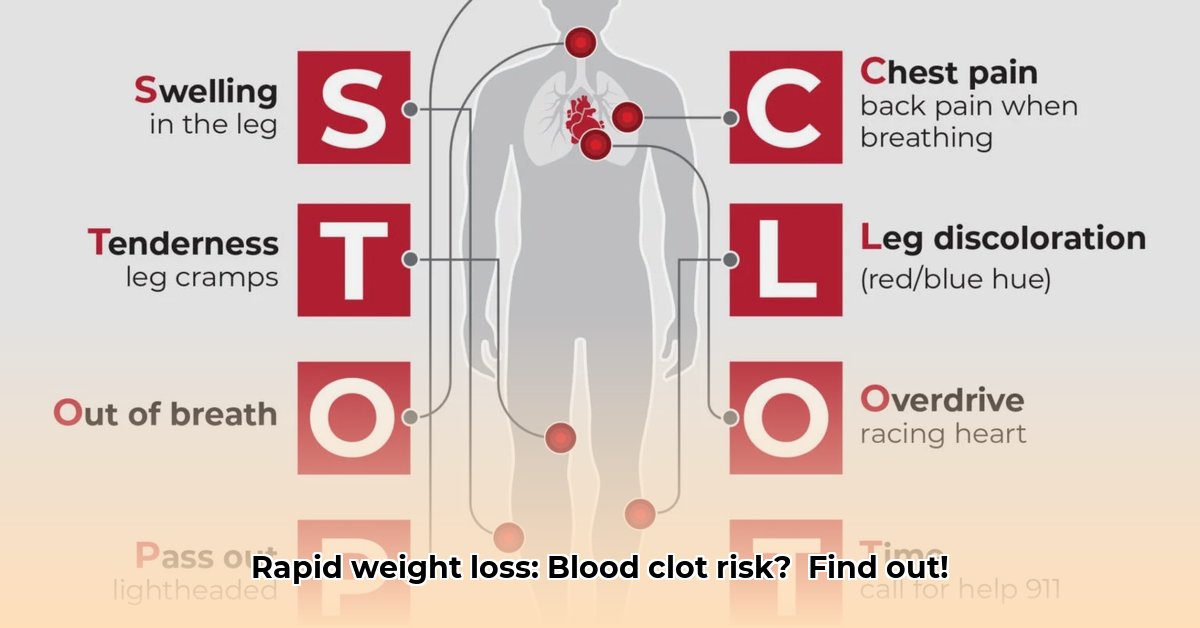
Obesity and Blood Clots: A Significant Link
Obesity is a well-established risk factor for venous thromboembolism (VTE), encompassing deep vein thrombosis (DVT; blood clots in the legs) and pulmonary embolism (PE; blood clots in the lungs). Studies consistently demonstrate a correlation between higher body mass index (BMI) and increased VTE risk. The exact mechanisms aren't fully understood, but several factors likely contribute, including changes in blood flow, elevated levels of clotting factors, and increased inflammation. This increased risk underscores the importance of weight management for overall cardiovascular health. But what about rapid weight loss? Does accelerating this process introduce new dangers?
Rapid Weight Loss and Blood Clots: Uncertainties and Cautions
The relationship between rapid weight loss and blood clots is more complex and less clearly defined. While significant weight loss generally reduces long-term VTE risk by addressing the underlying obesity, some evidence suggests that rapid weight loss might temporarily increase the risk. It's crucial to understand that this is not a definitive conclusion; more research is needed to fully clarify this association. The current data doesn't strongly support a direct causal link, but rather hints at a potential correlation needing further investigation. Consequently, recommendations must emphasize caution and medically supervised approaches.
Potential Mechanisms
Several hypotheses attempt to explain a possible link between rapid weight loss and increased clotting risk. Changes in blood viscosity (thickness) are a key area of investigation. Rapid weight loss may initially lead to hemoconcentration (increased concentration of blood components), potentially increasing the risk of clot formation. Furthermore, rapid changes in body composition can trigger inflammatory responses, which might also play a role. However, conclusive evidence is still lacking to confirm these mechanisms definitively.
Other Risk Factors for VTE
Beyond weight and the speed of weight loss, numerous other factors contribute to VTE risk. These include:
- Age: The risk increases with age.
- Family history: A family history of blood clots significantly raises individual risk.
- Medical conditions: Conditions such as cancer, heart disease, and inflammatory disorders increase susceptibility.
- Surgery or prolonged immobility: Post-surgical periods and extended periods of inactivity increase clot risk due to reduced blood circulation.
- Smoking: Smoking damages blood vessels and increases the likelihood of clot formation.
- Certain medications: Some medications, such as hormonal contraceptives, can elevate VTE risk.
The interplay of these factors significantly influences overall risk. An individual with multiple risk factors faces a substantially higher chance of developing VTE than someone with only one or two.
Recommendations for Safe Weight Loss
Safe and effective weight loss prioritizes a gradual approach guided by medical professionals. Here’s a structured approach:
Consult your physician: This is paramount. Before initiating any weight-loss plan, especially if you have pre-existing conditions, seek medical advice. Your doctor can assess your risk profile, guide you toward a safe and personalized plan, and monitor your health throughout the process.
Gradual weight loss: Aim for a sustainable rate of 1-2 pounds per week. This mitigates the potential risks associated with rapid weight loss.
Holistic lifestyle changes: Combine a balanced diet with regular physical activity and adequate hydration. Sustainable changes are more effective than rapid, unsustainable dietary restrictions.
Monitor for symptoms: Be vigilant. Symptoms of blood clots, such as leg pain, swelling, shortness of breath, or chest pain, require immediate medical attention.
Regular check-ups: Maintain open and consistent communication with your physician to monitor progress and adjust the weight-loss strategy as needed.
Conclusion: The Need for Further Research and Responsible Weight Management
The relationship between rapid weight loss and blood clots warrants further research. While obesity poses a significant VTE risk, the precise impact of rapid weight loss remains uncertain. Current evidence suggests caution, highlighting the importance of gradual, medically supervised weight loss for optimal safety and efficacy. Responsible weight management is a continuous process requiring a collaborative approach with healthcare professionals. Don't rush the process; prioritize your health and well-being by following a safe and sustainable path.